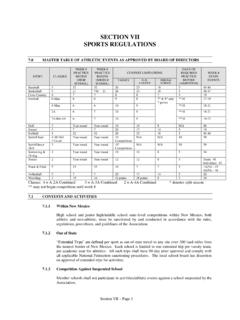Transcription of WCAL’s Roots Extend Back Eight Decades
1 WCAL s Roots Extend back Eight Decades The West Catholic Athletic League is not the first official sporting arrangement for Catholic high schools in Northern California. The league s organized Roots can be found in the Greater Bay Area s period of hyper-growth in the booming Decades after World War II. By the 1940s, a loose coalition of Catholic secondary schools had been scheduling each other on an irregular basis in a few, selected sports, according to George Baljevich, a longtime Bay Area teacher/coach at the high school and college levels who spent many of his working years at Catholic institutions, primarily in the East Bay. Available records indicate there were seven early post-war participants in what became known as the Catholic Athletic League (boys sports only): St.
2 Anselm s of Marin County, St. Elizabeth s of Oakland, St. Vincent s of Vallejo, St. Mary s of Berkeley, St. Joseph s of Alameda, St. Mary s of Stockton and Bellarmine Prep of San Jose. These schools did not compete against each other on a consistent basis. Bellarmine, for example, scheduled very selectively in football. Some press accounts during that bygone era referred to this collection more grandly as the Northern California Catholic Athletic League or the California Catholic Athletic League. But most followers eventually called it simply the CAL. New members came on board quickly as the Bay Area s population boomed and new Catholic high schools were opened on all sides of San Francisco Bay. Others dropped out. Competition became more formalized. Serra of San Mateo and Marin Catholic of Kentfield (replacing St.)
3 Anselm s by that time) joined in the late 1940s. Riordan of San Francisco (which has its Roots as the former St. James High School), Bishop O Dowd of Oakland and St. Francis of Mountain View did so in the 1950s. Marin Catholic departed the CAL late in that decade and became part of the Marin County Athletic League. But much bigger changes were in the air in the mid-1960s. In its heyday in the late 1950s and early 1960s, the CAL contained Eight schools: Bellarmine, O Dowd, Riordan, St. Elizabeth s, St. Francis, St. Joseph s, St. Mary s of Berkeley and Serra. When St. Ignatius was mandated to severely limit the percentage of non-San Francisco student-athletes on its sports teams by the Academic Athletic Association, the stage was set. Saint Ignatius exited the San Francisco AAA and agreed to become a member of what would become the WCAL in 1967, with Riordan administrator Ed Fennelly as commissioner.
4 They really had nowhere else to go, recalled former Serra athletic director Ken Houle, another architect of the WCAL s creation. It was a matter of necessity. Sacred Heart (now Sacred Heart Cathedral) followed its San Francisco colleague and arch-rival into the new league not long after that. The AAA was never the same. Neither was the CAL. The shift south by the two San Francisco schools into the new WCAL caused the CAL to be split in half. The East Bay schools continued as the CAL, adding a number of schools (Moreau of Hayward and De La Salle of Concord, among them). But it would not last. The East Bay-only version of the CAL was disbanded by officials of the North Coast Section in the late 1980s as extensive league realignments proceded (over the strenuous objections of the CAL and its many loyal adherents); its member schools were dispersed into various East Bay public school leagues and they participate there to this day.
5 The CAL s last commissioner, Bob Robert, recalled that the league s devotees used every legal lever at their disposal to fight the NCS move but were unsuccessful. We fought it, he said, but, in the end, we lost. Today, only the WCAL remains _ and thrives. The WCAL s mission is to provide for the administration of athletic competition among its member schools. The WCAL is a member of the Central Coast Section (CCS) of the California Interscholastic Federation of Schools (CIF). Originally, the WCAL provided competition for boys only. In 2002, the Central Coast Section, through its realignment process, brought girl s competition to the WCAL. Currently there are ten member schools and one supplemental school providing athletic competition in thirteen different sports for Boys, and eleven sports for Girls within the league.
6 Since its inception in 1967, the West Catholic Athletic League has become a dominate force in the Central Coast Section and is considered by many to be the most competitive league, top to bottom, in Northern California. The boy s teams have won 343 section championships, while individuals have taken home the gold on 370 occasions. The girls programs have acquired 141 section team titles and 97 individual titles. On the state level, the boys have won 33 Northern California team titles and 7 CIF State championships along with 19 second place finishes. Boy s individuals have 9 Northern California individual titles and 5 state championships. In girl s competition statewide, 64 Northern California team titles have been achieved along with 35 state championships and 22 runner-ups. Individuals have won 2 Northern California first place medals and 2 state championships.
7 Current membership includes: Archbishop Mitty (boys and girls), Archbishop Riordan (boys only), Bellarmine (boys only), Junipero Serra (boys only), Presentation (girls only), Sacred Heart Cathedral, (boys and girls) Sacred Heart Prep (boys and girls, Water Polo only) Saint Francis (boys and girls), Saint Ignatius (boys and girls), and Valley Christian (San Jose) (boys and girls). The governing body of the WCAL is the Principals Council, composed of the Principals of all the member schools. The Principals Council meets four times each year to decide issues involving the league. The Athletic Directors Council, composed of the Athletic Directors of all member schools, is the advisory body to the Principals Council. The Athletic Directors Council meets six times each year, and makes recommendations to the Principals Council regarding league rules, procedures, policies, schedules and other matters which are deemed necessary.
8 Finally, there are Sport Committees for each league sport. A Sport Committee is composed of all the Varsity Coaches of the same sport. Their function is to meet periodically each year to discuss any and all aspects of their sport with the intention of improving the sport and the WCAL as a whole. They make recommendations to the Athletic Directors Council regarding changes, revisions, additions or deletions to existing league rules and procedures which govern their sport. The WCAL employs a League Commissioner who has the responsibility of liaison between the Principals Council, Athletic Directors Council and the Sport Committees. The League Commissioner is the main administrative and financial officer for the entire league. The League Commissioner prepares the final schedules, records brochures, and League Constitution and Sport Bylaws every year, and distributes copies of these documents to every school.
9 League Championships are determined for each sport. The results of the round robin league schedule solely determine the championship in Basketball, Football, Soccer and Tennis. The League Championships in Baseball, Softball, Lacrosse, Water Polo, Volleyball, Golf, Swimming, Wrestling and Track allow for possible co -champions. The co-champions in these sports would be the team that wins the round robin together with a different team if that team wins the League Playoffs. League Playoffs are held after completion of the round robin season. All teams who participated in the league round robin schedule are eligible for the League Playoffs. If the same team wins both the round robin and the league playoffs that team shall be the sole league champion of that sport. Finally, the League Champion in Cross Country shall be determined by the combined results of the round robin competition and the final league meet.
10 John Horgan contributed to early CAL history







